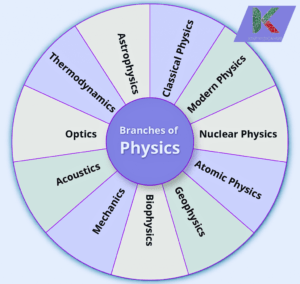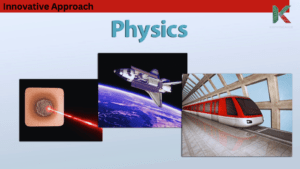What is Physics? Understanding its Concepts, Branches and Applications
Physics isn’t another field of science. Rather the foundation on which our knowledge is built. Referred to as the core science, it connects areas, like chemistry, biology and geology by offering key concepts and methods to explain how complex systems work, from tiny atomic structures to vast ecological networks. Its theories and experiments underpin the principles of chemistry and engineering help us grasp processes and drive engineering advancements. So what is physics and why does it matter so much? Let’s have a detailed look at its principles.
What is Physics?
At its core physics is the discipline that governs how matter and energy interact providing insights into the world and driving progress in engineering fields. It’s about exploring phenomena through systematic observation, experimentation and measurement to test hypotheses and refine theories as theories interpret facts. Physics seeks to create a framework for comprehending the forces of nature that govern everything from subatomic particles to vast cosmic entities, in the universe.
Significance of Physics
Physics principles are essential, throughout our lives ensuring that our world operates smoothly securely and effectively. Electromagnetism comes into play helping to understand how electric currents brighten up our living spaces when a switch is turned on. The warmth of our morning coffee is dependent, on the principles of thermodynamics which explain the transfer of heat from the stove to the pot and eventually to the liquid. Our smartphones and computers are results of advancements in quantum mechanics, which explains the behavior of semiconductors for electronics.
Even basic activities like tossing a ball involve mechanics laws that outline how the ball moves in response to gravity and air resistance. During a car journey the engines effectiveness is explained by laws while GPS navigation systems utilize principles from Einstein’s theory of relativity for accurate location tracking. Physics plays a role in our exploration of the universe laying down the foundation for sciences and driving technological progress.

Fundamental Concepts in Physics
Matter, energy, space and time, force, and conservation laws are the basic concepts that are interconnected and significant for understanding a vast array of physical phenomena.
-
Matter
Matter refers to anything having mass and volume which is made up of components like atoms consisting of particles such, as protons, neutrons and electrons.
For Example: Consider a book made up of atoms occupying space on a desk.
-
Energy
Energy is the ability to perform tasks or bring about changes. It comes in forms such, as motion, position, heat, chemicals, nuclear power and electromagnetic waves.
For Example: The energy stored in batteries fuels your smartphone.
-
Space and Time
Space refers to the three space where objects and events exist with their positions and directions. Time, on the hand is the progression that organizes events from past to present to future.
For Example: Consider a scenario where a car moves from point A to point B in space at a speed over a period of time.
-
Force
Force is an action that alters the movement of an object often described as a push or pull resulting from interactions between objects.
For Example: Gravity acts as a force causing an apple to drop from a tree to the ground.
-
Conservation Laws
Conservation laws state that certain properties of an isolated physical system remain constant over time, reflecting fundamental symmetries in nature. These laws affirm that specific attributes of a system remain constant over time reflecting inherent symmetries in nature.
For Example: Consider law of Conservation of Energy as an illustration: Within a system like a roller coaster while potential energy transforms into kinetic energy during descent the overall energy remains constant.
Different forms of matter and energy engage through forces within the spacetime framework. The conservation laws depict predictable regulations that maintain stability and equilibrium, in processes.
Branches of Physics
-
Classical Mechanics:
Definition: Classical mechanics ( physics before the 19th century) deals with the study of motion of objects at intermediate level under the action of applied forces. Newton laws of motion and principles of conservation are core of classical mechanics.
Explanation: This branch of physics plays a role in comprehending certain specific phenomena like the flight of an object that is thrown or even planetary motion around the sun.
For instance, Consider driving a car as an example of an activity that is considered to be safe, but in essence is not. The principles of classical mechanics are used to explain how the force produced by an engine propels a car, how the use of brakes for slowdown is applied or the car’s response to turning which involves centripetal force.
-
Thermodynamics:
Definition: Thermodynamics is the branch of energy in which heat and efficiency are relations of energy. It gives an insight into what is understood in terms of temperature and entropy, heat transfer, and other laws applicable to energy conversion.
Explanation: This is the branch of physics that forms the foundation for the modeling of engines, refrigeration processes, as well as a climate since it defines flows and transformations of energy in various systems.
Example: Air Conditioning: Based on thermodynamics principles air conditioning is a system that facilitates the movement of heat from the interiors of a building such as a house to the exterior making the interior cooler.
-
Electromagnetism:
Definition: Electromagnetism defines how electric and magnetic fields are related; this area is covered by the equations of Maxwell. It covers facts such as the behavior of light, electrical conductivity, and electromagnetic waves.
Explanation: Electromagnetism is an essential feature of engineering and techno sciences in the world that transports, transmits, and processes information from electric power industries to communication systems and medical technologies.
Example: Working Principle of a Microwave: We all know that food has water content in it, microwave oven uses electromagnetic waves, which heats this water content thus heats the food.
-
Quantum Mechanics:
Definition: Quantum mechanics involves the study of the behavior of matter particles at microscopic levels and energy where the tentative laws of statistics, dual-wave and particle nature of matter, and uncertainty principle proposed by Heisenberg.
Explanation: The principles of Newtonian mechanics and the laws of quantum mechanics revolutionized the considerations of the atomic and sub atomic world to produce the concepts of Semiconductors and Quantum computers.
Example: Semiconductors in Electronics: The device that we use in our daily basis such as the computer, smartphones, and transistors in them function through quantum mechanics since electron current must be controlled.

-
Relativity:
Definition: Relativity here refers to theories formulated by Albert Einstein that have two categories known as the special relativity and the general relativity. It explains the relation of space and time, the role of gravity in spacetime curvature, and time dilation and length contraction.
Explanation: Albert Einstein revolutionized the understanding of the universe with this theory, and its effects are seen in advancements in GPS, astrophysics, and in the understanding of black holes as well as the expanding universe.
Example: GPS Systems: basically GPS accuracy relies on corrections for time dilation since satellites orbit at a higher speed than the human rate on earth.
-
Nuclear Physics:
Definition: Nuclear physics involves nuclear matter, nuclear processes where nuclei are changed to other nuclei, strong nuclear force, and weak nuclear force. It deals with radioactivity, nuclear energy or power and the framework of matter.
Explanation: Indeed, nuclear physics has many applicative uses, from the generation of power, to medical diagnosis, to discovering the formation of elements in the universe.
Example: Smoke Detectors: The most effective of them all are the smoke detectors which have a small amount of radioactivity into it so that they can ionize the air as well as the smoke particle so that they can set off the alarm.
-
Optics:
Definition: Optics is the branch of physics that is used to describe the wave -nature of light; the behavior of light when it passes through different materials; and most importantly the construction of images. It is comprised of aspects like reflection, refraction, diffraction, and polarization.
Explanation: Optics plays a crucial role in the development of lenses and lens systems, microscopes and telescopes, lasers and fiber optics, and notably lifts up astronomical studies and telecommunications.
Example: Eyeglasses: Optics shows how lenses which are in eyeglasses change direction and focus of light to give a correct impression to the eye’s retina.
-
Particle Physics:
Definition: Particle physics concerns itself with the basic particles and their behavior and how they can be further divided or combine with one another. It is a branch of physics which explores the dynamics of matter to its core by looking at constituent elements such as quarks, leptons, bosons and other elementary particles.
Explanation: Particle physics deals with the components of the universe at the smallest scale and helps in designing advanced machines such as the Large Hadron Collider.
Example: Carbon-14 dating: Its application is in archaeology, geology and other disciplines to determine age of the fossils found and provide knowledge about past and changes in environment.
-
Condensed Matter Physics:
Definition: Condensed matter physics is a subdiscipline of physics that tries to explain properties of materials that are in solid or liquid phase. Huge phenomena like super conductivity, magnetism, phase transitions, etc are studied with its help.
Explanation: Condensed matter physics is the foundation of various technologies, including computer chips, superconductors, and nanomaterials, ensuring continued advancements in electronics, materials science, and quantum technologies.
Example: Magnetic Superconductors and the Physics Behind Them – Discovering why specially developed materials offer no electrical resistance at extremely low temperatures results to the use of MRI machines in hospitals today.
Overlapping of Physics with Other Fields
-
Biophysics:
Definition: As a discipline, biophysics focuses on the analysis of biological phenomena using concepts and tools of physics on molecular, cellular, organism, and population levels. Biophysics uses physical forms of technology in analyzing the properties and actions of Bio – molecules (DNA, proteins), actions taking place within cells and structural and functional units of the body.
Examples: Medical Imaging: Techniques like the computer tomography, CT scans or magnetic resonance imaging MRI involve electromagnetism principles and nuclear physics to preview body structures thus helping diagnose potential disease.
-
Physical Chemistry:
Definition: Physical chemistry covers systems and processes in chemical systems/Chemical physics or physical chemistry is a branch of chemistry that deals with systems and processes at the molecular and atomic level using principles from physics such as quantum mechanics and thermodynamics and properties such as energy, velocity, and frequency. Molecular chemistry gives a clearer perception of the nature of the change and interconversion of substances at a molecular level.
Examples: Cooking: A knowledge of basic thermodynamics and its impact on the process of chemical changes in the food items such as the browning agents known as the Maillard agents.
-
Astrophysics:
Definition: This branch of science applies physics concepts to study the universe, and it covers the behavior of stars, planets, galaxies and black holes.
Example: GPS Systems: the principles of orbital mechanics and relativity can be beneficial in maintaining satellites in the right position to facilitate accurate GPS in the surface of the earth.

-
Engineering:
Definition: Engineering links with physics for the development and implementation of structures, tools, and other systems, addressing applied physics in practice.
Example: Automobiles: Thermodynamics applied for converting heat into work in an engine, fluid dynamics for drive and styling and classical mechanics for work and force.
-
Geophysics:
Definition: Geophysics is defined as the branch of geology that investigates the Earth and its components or structure, the constituent materials, or the processes that shape it. This field utilizes physics concepts to analyze geophysical events like earthquakes, magnetic and gravitational forces acting on the earth and the internal structure of the earth found in geophysics.
Example: Earthquakes: Seismology being a sub-discipline of geophysics, revolves around physics of waves to investigate about the earthquake waves and assists in the construction of structures that would hold up against earthquakes.
-
Environmental Physics:
Definition: Environmental physics is the study of physical processes and physical interactions taking place in the environment mostly in the atmosphere, the hydrosphere, and biosphere to solve environmental problems. It uses principles of physics to analyze such matters of topical interest as climate change, air and water pollution, and renewable energy.
Examples: Weather and Climate prediction: Physics based climate models aim at describing the climate and the changes in weather by studying the effect of different atmospheric conditions based on thermodynamic and fluid dynamic properties.
Physics: The Basic Science
Physics unquestionably is the first science since it gives the theoretical framework and seminal laws governing the enormous number of processes in the universe. Whether dealing with the movement of galaxies, the behavior of particles or anything in between, it provides the fundamental tools and ideas to explain and anticipate the operations of the universe. Its principles spread their influence into nearly all of the other sciences; it serves as the foundation of technology and science.
-
Role in Interdisciplinary Research:
Physics provides many methodologies and comprehensive theoretical methodologies that form a strong support for interdisciplinary studies. As a fundamental science, the principles of physics enrich and support biology, chemistry, earth science, engineering, astronomy, and medicine while also providing the solution to many complicated issues based on real-world applications.
Explanation with diverse examples:
Exoplanet Exploration: Doppler spectroscopy and transit photometry, fundamental principles of wave mechanics and electromagnetic radiation are used to detect and characterize planets around stars beyond the solar system.
Robotics: Knowledge in dynamics, control theory and material properties which stems from physics is important in the development and enhancement of robotic technologies for commercial use from industries to aerospace.
Health Care: Methods from physics can also be used to take very accurate pictures; such as MRI and CT scans, deliver radiation to specific parts of the body; such as proton beam therapy to treat tumors and create medical devices.
Dark Matter and Dark Energy: They are the strange substances of the cosmos that engage the combination of astronomy and theoretical physics to analyze their nature and impact on cosmic development.
-
Role in Innovation and Technological Advancement:
This research has played a significant role in exploring the particular field of innovation and comparative analysis with different advanced nations and their approaches towards technological advancements. Physics is considered to be the core for various advancements and creations that have greatly transformed the Human life. From the innovation of the upcoming computing technology to the generation of renewable energy, the usage of physics emerges as an indispensable factor in building for the future.

Explanation with diverse examples:
Transportation: From the designing of aircraft and automobiles to rocket propulsion technology, satellite technology and interplanetary travel.
Communication: Growth in electronic gadgets such as radio, television, mobile phones for free internet and fast data transfer.
Energy Solutions: Creation of nuclear reactors to meet the energy demands of countries and the development of non-renewable energy resources including the development of solar panels and wind turbines.
-
Predictive Power of Physics:
Physics is remarkable in its capability to make prediction on future phenomena in the scientific world. It provides the capacity to convert numerous natural processes and occurrences into manageable and calculable occurrences. This predictive ability originates from the fact that most physical phenomena can be modeled using precise mathematical equations and stable, well-defined parameters.
Explanation with diverse examples:
- The laws of motion formulated by Newton help us to calculate the path of the space shuttle that will send spacecraft to distant planets.
- Likewise, Maxwell’s equations assist engineers in designing effective wireless communication systems since the equations depict how the Electromagnetic wave spreads out in space.
- Schrodinger’s equation used in quantum mechanics helps chemists in determining the behavior traits of atoms and molecules resulting in drug discovery.
Conclusion:
Physics is one of the most fundamental sciences that studies the fundamental principles of how matter and energies function. It is therefore of greatest importance in the pursuit of knowledge concerning natural phenomena and the development of technology in various disciplines. Matter and energy, space and time, forces that exist in the universe and laws that in some way govern the processes in the Universe, are some of the fundamental concepts in physics.
Mechanics, electromagnetism, thermodynamics, quantum mechanics are the fields of physics, which make us understand how the world functions and how evolution of physics occurred. Physics is closely connected with other sciences such as chemistry or biology, which helps us to explain pieces of information more comprehensively if they are linked with several branches of science.
In conclusion, physics can be considered as the ultimate source of knowledge about the ways of the world starting with subatomic particles and extending to galaxies. It makes us able to understand not only what is happening in the world but also develop new technologies and enhance our lives. Regardless of understanding how automobiles work, enabling the gadgetry of portable smart phones and computers, or how airplanes fly, physics is important. It is still defining our movements toward or away from knowledge, it defines the way we live and guides us for further discoveries in the future.